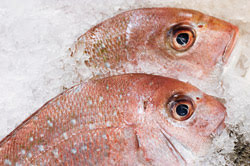Spectroscopic techniques young and old continue to expand knowledge of biological systems.
Spectroscopy may not be the longest-reigning example of the sciences we now group together as photonics, but it has had a long and very successful tenure at helping people understand the processes that sustain – and occasionally diminish – life.
 In the biotech venue, spectroscopic techniques are used for everything from cell biology to quality assurance on the pharmaceutical factory floor. There are myriad applications, each one depending on a specific flavor of spectroscopy that has its own arrangement of optics and an innovative twist that enables a novel discovery. Among the application areas gaining the most interest recently are food safety, forensics, and defense and public safety efforts, including on-site detection of biological threats such as anthrax.
In the biotech venue, spectroscopic techniques are used for everything from cell biology to quality assurance on the pharmaceutical factory floor. There are myriad applications, each one depending on a specific flavor of spectroscopy that has its own arrangement of optics and an innovative twist that enables a novel discovery. Among the application areas gaining the most interest recently are food safety, forensics, and defense and public safety efforts, including on-site detection of biological threats such as anthrax.
In addition, the recent introduction of ultrafast lasers that produce pulses of light only tens of femtoseconds in duration has pushed research into the speedy processes of molecules in motion. Until recently, the technology was relegated solely to imaging supertiny objects moving at superfast speeds, such as the conformational changes undertaken by proteins and other molecules under certain conditions. Exciting enough, but the technology has been pushed to the point where spectrographic information can be read from the objects as they are scanned. Changes in molecules as they form and break bonds, for example, now can be tracked, including interactions between viruses and antibodies in vivo, as can the material changes that occur in cellular components as they perform their everyday tasks.
New roles for Raman
Aside from improvements in some types of lasers, the tools of the spectroscopic trade haven’t changed much in the past several years. Ultimately, spectroscopy comes down to bouncing light from an LED, a laser or even an old-fashioned flame off a substance and recording the wavelengths of the energy emitted in return. Incremental changes abound, however, especially in the expanding role of Raman spectroscopy into a variety of fields.
Various forms of the latter technique, such as surface-enhanced Raman spectroscopy, are garnering much interest from researchers seeking ways to improve the notoriously weak signals provided by the scattering of the odd remnants of light energy that are key to the Raman technique. Cell biology in general, and related engineering efforts, such as the development of biomaterials and biomimetics, are dependent upon good material characterization. Raman spectroscopy provides excellent characterization data, but Raman-level emissions that are easily overpowered by non-Raman radiation must be enhanced to count effectively.
A number of scientists are continuing to develop novel ways to improve Raman signals, mainly by placing spectroscopic targets on metallic substrates composed of substances designed to boost signal strength. Typically, either silver or gold is used to make these substrates, but because the exact mechanism for the enhancement of the Raman signal is unknown, other materials are subject to testing.
If the target material is too small to relocate onto a microscope stage for analysis, an alternative is to bring the enhancement to the particle. Nanomaterials coated with gold can be fabricated and brought into proximity with target particles, with the same Raman enhancement occurring. This technique could be used for in vivo investigations of disease mechanisms.
Arrays of gold-coated nanorods are being explored by researchers at the University of Georgia for possible use as Raman-enhancing substrates. Jiping Zhao’s group at the university has developed such an array, which Zhao believes can be useful as a hypersensitive biosensor capable of distinguishing chemicals in the attomolar volume.
Other ongoing efforts are under way to use Raman spectroscopy to detect dental cavities before they are visible to the eye as well as to help differentiate forms of nonmelanoma skin cancers.
At the market
In the realm of food and drink analysis, techniques such as Fourier transform infrared spectroscopy are being fine-tuned to address specific problems. Fruit and vegetable producers and distributors, for example, are working to refine methods to develop seeds, grow plants and ship the results profitably around the world. Visible, infrared and near-IR spectroscopy are all used to various degrees to study the nutritive qualities of new cultivars.
 In one recent case, Alain Clément of Agriculture and Agri-Food Canada and his colleagues developed a method to nondestructively test tomatoes for their lycopene content, an important antioxidant. Nondestructive methods enable distributors to test produce without removing samples from the production process, thus speeding shipping while simultaneously ensuring that fruits and vegetables meet manufacturing standards.
In one recent case, Alain Clément of Agriculture and Agri-Food Canada and his colleagues developed a method to nondestructively test tomatoes for their lycopene content, an important antioxidant. Nondestructive methods enable distributors to test produce without removing samples from the production process, thus speeding shipping while simultaneously ensuring that fruits and vegetables meet manufacturing standards.
Spectroscopic techniques are not limited to produce from the field. Methods are available to test the quality, nutritional capacity and even taste of fish, fowl, beef, dairy products, beer, wine and soda.
Concern over the provenance of high-end food and drink – such as some wines, brandies and olive oil – has led to a similar spectroscopic charge toward distinguishing the real from the fake. Scientists at University College Dublin and at Ashtown Food Research Centre, both in Dublin, Ireland, recently described their efforts to use near-IR spectroscopy to confirm the geographical origin of olive samples taken from scattered points around Europe. Accurate methods to prove authenticity of expensive foodstuffs soon will attract the attention of venture capitalists who will recognize the potential flow of money.
Every substance that we eat, drink, breathe in or otherwise ingest interacts for good or ill with our biological systems. Spectroscopic technologies and techniques will help us develop more awareness about these interactions.